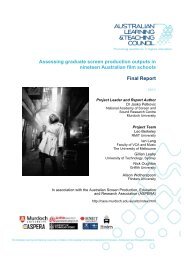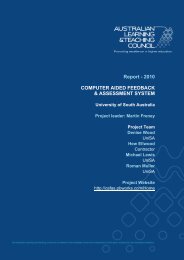Download Document - Office for Learning and Teaching
Download Document - Office for Learning and Teaching
Download Document - Office for Learning and Teaching
Create successful ePaper yourself
Turn your PDF publications into a flip-book with our unique Google optimized e-Paper software.
From Table 65, we can see that there is some difference in the distribution pattern ofresponses between Australian <strong>and</strong> international students of each set of data.However, it is obvious that those amongst Business students were more radical. Itis true that amongst Business students, the main reason both Australian <strong>and</strong>international students gave <strong>for</strong> why they think the teaching methods in their currentsubjects were not suitable <strong>for</strong> them was because they didn’t like them. However,25% of international students stated that the teaching methods were different fromthe teaching methods in their previous education, <strong>and</strong> over 20% of the internationalstudents also felt that the teaching methods were difficult to accept due to theirlanguage. Australian students, on the other h<strong>and</strong>, did not have the same issues <strong>and</strong>chose “others” as their second main reason.2) Experience with credit-point systemsQuestion:IV.1. Do you have any experience with credit-point systems in your previouseducation?A. YesB. Some experienceC. Very littleD. Not at allCorrelation analyses per<strong>for</strong>med on the three sets of data show that there is someassociation between the response pattern <strong>and</strong> the categories (Australian <strong>and</strong>international) of students from all three sets of data. However, the statistics from theIT student data group appeared to be strongest (Phi & Cramer’s V of 0.310). Table66 shows a summary of responses distribution amongst the three sets of data <strong>for</strong>question IV.1.Table 66. Distribution of responses to question IV.1 from overall students, ITstudents <strong>and</strong> Business students::Overall Students IT Students Business StudentsAust Intl Total Aust Intl Total Aust Intl TotalYes 15.0% 38.1% 29.4% 18.0% 47.4% 37.3% 13.3% 31.1% 24.0%Some 14.7% 19.1% 17.4% 17.0% 16.7% 16.8% 15.2% 20.5% 18.4%experienceVery little 16.0% 14.3% 15.0% 8.0% 6.3% 6.8% 19.9% 19.9% 19.9%Not at all 54.3% 28.5% 38.2% 57.0% 29.7% 39.0% 51.7% 28.6% 37.7%Total 100% 100% 100% 100% 100% 100% 100% 100% 100%Count 381 635 1016 100 192 292 211 322 533From Table 66, we can see that in comparison to the other two sets of data, the ITstudents group has the highest proportion of international students (over 47%) whohad experience of credit-point systems in their previous education, compared to only18% of Australian students in the same group who said the same. Similarly, the ITstudents group also has the highest proportion of Australian students (57%) who didnot have any experience with credit-point systems in their previous education. Theproportion of international students in this group who did not have any experiencewas only about 1% above the same in the other two sets of data.3) English language-related difficulties in underst<strong>and</strong>ing lecturesQuestion:V.2. Do you have any English language-related difficulties in underst<strong>and</strong>ing124
















